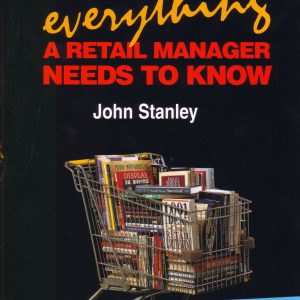Vision 20/20 The Next Decade for Independent Garden Centre
If there is one guarantee, it is that independent garden centres will look completely different in the years to come. The existing model has worked well over the last few decades but now is the time to change.
The changes are due to a number of reasons. A changing economy, technology and consumers who are changing their shopping habits. All of these factors mean the existing model will have to change if independently owned garden centres are to prosper in the future. This has been something I have been studying for some time, hence the White paper.
The White Paper written by myself and Trevor Cochrane and with contribution from Malcolm Scott is a strategic document. It provides our view of the changing retail scene and this allows individual garden centres to then prepare their business plans to develop their own business as a result of the ideas we present.
The Paper takes a global view of the industry and we provide examples from around the world and this allows individual companies to look at how their business fits into global as well as local trends
The Paper which was sponsored by Monrovia Nurseries in the USA is divided up into a number of sections to help you develop a journey of change.
Why Write A White Paper?
Change will take place anyway, so why write a White Paper on our thoughts on how the industry should change?
The idea of writing a “White Paper” has been buzzing around our heads for a couple of years. All businesses in all business sectors have seen radical changes in recent years, the world is changing; and changing at a rate never seen before. Retailers now must move at a rate never experienced before and garden centers have not been divorced from these challenges and opportunities…
The industry was “rolling” along nicely, or was it?
It really wasn’t. In the 60’s and early 70’s garden centers had strong buying and promotional groups. Garden centers became the “top” end players around the world but then the supermarkets entered the category. In the 1980’s discount and price perception arrived and the industry had a new challenge to manage. Since then decline has been evident for twenty years in independent ranks. John Stanley told the Nursery and Garden Industry Association of Australia conference in Queensland Australia in the 1990’s that 50% of retailers would be decimated by big box retailing. 75% of those garden centers present at that talk have since disappeared including several iconic Australian retail brands. Not only that but market share shifted between mass merchants or supermarkets and discounters losing garden category sales to mass merchant home improvement outfits.
Then in 2009 and 2010, Global Financial Crisis (GFC) changed the retail scene for everyone. The garden industry witnessed consumers change dramatically in their values, desires and resultant shopping habits. The stock market in 2011 has not improved; it is still at the same level in 2011 as it was at the start of the GFC in late 2008 and indicators show a slow economic trading environment well into the next decade.
Additional issues that are changing the garden industry include the revaluation of currencies, including the US dollar and Pound Stirling. The rise of China and the emergence of India as economic powers will also have considerable impact on retail in the future.
Finally a paradigm shift in purchasing habits has left traditional store based retailers with a significant disadvantage to the new retail store front. Web based retailers without typical shop overheads have suddenly been embraced by the broader community and are booming as consumers gain confidence in web security and recognise the price advantages which are now being promoted through mass media. This may be magnified by the reality that tough economic trading conditions traditionally see discount retailers perform exceptionally well as consumers hunt bargains.
All of the above issues have created a crisis for the garden center industry today. This crisis has been accompanied by the fastest growth in new technology in human history.
The computer moved from the office place to become a normal piece of equipment in the home. If you do not believe changes are taking place take a look at the amount of smart mobile phones being used in leading retailers and even the parking lot. Many garden centers have struggled to embrace computer technology/web opportunities and some today still don’t even have computers. It seems like everyone is wired into a different world except for garden centers.
The garden sector in 2011 is valued at $70B in retail value in the USA [minus garden furniture], USD $20B in the UK and AUD $7B in Australia. The garden industry has long been recognised by mass merchants as a significant opportunity but a difficult category to deal with. However mass merchants now recognise major opportunities in the garden sector and are developing new marketing strategies to grow market penetration within the sector.
When a retail category is identified to be of substantive value it inevitable that corporate retailers will attempt to market share and dominate the category.
An interesting footnote to this information comes from Australia’s leading pot manufacturer who owns an unprecedented 95% of the plastic pot market. Graeme Wilson believes that plant production has decreased between 30 – 50% in the past 8 years. This is despite the enormous growth of big box retailers and begs the question has mass merchant retailing impacted independent retailers as significantly as commonly thought or is it a combination of factors including housing block footprint reduction, increase leisure dollar competition from other categories and a lack of value perception that has erodes sales within the green-life category.
The opportunities that lay ahead for retailers
In just twenty years there will be 9.5 billion people on the planet, up 3 billion on today’s number. Urbanisation is growing at an unprecedented rate with more people moving to cities than ever before. This will put extra pressure on available land as far as food production and cost of land is concerned. Set against this is a decline in available farm land for food production. This will inevitably result in rising food prices. Rising food prices and the desire for fresh, clean food will continue to drive home food production. Home food production will have an impact on garden centers retail merchandise mix for many years to come.
[1]A report came out in June 2011 in Australia that revealed that already the new young consumers preferred to live in apartments in cities rather than have a “quarter acre block” in the suburbs. This trend will continue and the balcony garden will be a major category in retail stores in the future.
Figure 1: Population growth as seen for space and modified to show the earth at night. The lights represent man-kinds footprint on the planet in 2010. By 2030 this footprint is estimated to be 50% larger.
Overall this is a time of major change for the industry and the changes are taking place at a rapid rate.
This means every business involved in horticulture has to change now to adapt to these changes if it is to prosper in 2020 and beyond.
The key to success in the future will involve three key strategies;
- Embracing change – particularly utilising technology,
- Identifying the business model of the future that best suits your business,
- Evolving to develop a new approach to attracting and caring for customers will be paramount to survival in a time when globalisation is quickly swallowing many industries.
Where do you start and how do you progress?
This single question has been the biggest challenge for many retailers, growers and suppliers in the industry. But rather than fear the future and the radical change to the industry, now is the time to view these changes as the greatest opportunity in recent history for the independent garden industry to grow its share of the leisure category dollar.
This paper outlines the logic behind these assumptions and highlights models that are revolutionising the level of service, the quality of retail offer and the care of customers in the gardening sector.
This White Paper looks at the industry globally; where it stands now, but more importantly, what strategies independent retailers need to implement to survive the radical onslaught of globalisation, big business and new market models.
The authors have identified and developed a series of strategies presented in a logical progression with the aim of encouraging you to develop new ways of thinking about issues so that you can create your own future strategies to cope with the changes in the industry.
The decisions you make in the next few months on how to develop your own business are critical to its long-term success.
What Does The White Paper Contain?
- Overview of the Existing Market
- The Industry today…where has it come from?
- The Independent Garden Center Evolution
- The Garden Industry Size and Value
- The Garden Retail Market
- Consumers – Changing Consumer expectations
- Opportunities
- What is changing? It is you and I? Managing Changing Habits
- The Trust Shift
- What do we sell?…have we lost our way?
- Improving Profitability
- Value versus Premium…How Pierce Brosnan sells baked beans
- The Future
- The Current Business Model
- The Future model
- The Trends…are you keeping up?
- Fashion Trends…its more than colour
- Diversification
- Key Changes to Existing Business strategies
- Retail Trends
- Trends are consumer driven
- Marketing
- Free Marketing…Use it to Your Advantage
- The Future Garden Center….Market with a Cause
- Join YOUR Community
- Social Conscience Community ownership
- Talking With Your Customers inside your Store
- The Future Garden Center
- Merchandising and display… Become a Show Stopper
- Own the Market…..before your competitor does
- Become a Guerrilla in your Marketing Style
- Education is critical
- The Future Garden Center
- Product and Services…and what we learnt from our local pool shop
- B2B Services
- The Future Garden Center…designed to be profitable
- Will the future be “Pop Up” Garden Centers?
- Urban Farming….The Next trend??
- The Future Garden Center…a New Way of Thinking, designed to be profitable
- When will the Virtual Garden Center Arrive?
- Grab and Go or Online Shopping
- Can You Change?
- Get ready for change
- Prospering in the Future
- The Next Step
- Experience Retailing…Is it really happening for you?






